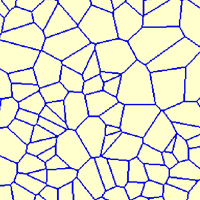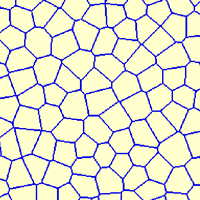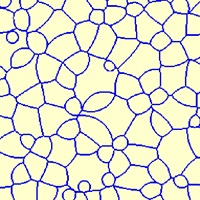Microstructure¶
Stabilisation and analytical curvature¶
If a particle is smaller than the numerical interface thickness, the phase-field algorithm is not suitable to evaluate the correct curvature of the particle. This is a problem for nucleation, because new grains upon nucleation are typically much smaller than the typical microstructure length scale. Inoculants which are often added to commercial alloys for grain refinement are usually much smaller than the numerical interface thickness (< 1 \mu m). If after nucleation the grain diameter (grains are assumed to start growing on a spherical seeding particle with the same radius) is much smaller than the grid spacing, the grains are treated using an analytical expression for the curvature1. The analytical curvature feature uses a full equivalent curvature instead of the phase-field curvature.
As already explained in input section Grain Input, using the stabilisation feature, a reduced curvature is assumed at a given stage instead of the phase-field curvature. When the stabilisation option is used, the curvature term is neglected until a sufficient size is reached and curvature can be turned on continuously. Typically, the central cell of the new grain needs at least a fraction larger than 0.5 to be able to be grown by the phase-field algorithm (for triple junctions it may be more complicated). In MICRESS®, the curvature increases linearly with the fraction of the central cell, i.e. the full curvature is experienced not before the grain reaches full size (the central cell has a fraction larger than 1-phMin).
The stabilisation option assumes a growing seed. If the critical radius is larger than the grid spacing, the seed will neither grow nor vanish, i.e. it is metastable because of the artificial curvature reduction. This stabilisation may be terminated by using the kill_metastable flag. To avoid this situation (due to a very small grid spacing, high interfacial energy or small stored energy), the option analytical_curvature should be used.
Voronoi construction¶
The Voronoi construction is a weighted construction of an initial grain structure. The radii are used as weighting factors for the distances. A standard Voronoi construction is obtained by equal radii which lead to straight boundaries. The curved boundaries which can be achieved by choosing slightly different radii are often more realistic (Figure 1), especially to define initial structures for grain growth simulations (Figure 2)
Figure 1¶
The Voronoi construction
During grain ripening, the triple junctions are moving according to their deviation from the equilibrium angle, and the grain boundaries follow their movement driven by curvature. Whether one starts a simulation with a weighted Voronoi construction (curved boundaries) or with a simple Voronoi construction (straight boundaries) depends on the initial assumptions: if one assumes that the initial structure is formed by growth (e.g. recrystallisation), then the simple construction is more appropriate. On the other hand, if it is assumed that some ripening of the structure has already occurred, but this initial ripening shall not be simulated explicitly, one could use the weighted construction model to be closer to a typical steady-state microstructure.
Figure 2¶
Applying the Voronoi criterion
| r_\min = 80 r_\max = 100 | r_\min = 100 r_\max = 100 | r_\min = 100 r_\max = 200 | r_\min = 100 r_\max = 400 |
|---|---|---|---|
 |  |  |  |
-
Ingo Steinbach. Phase-field models in materials science. Modelling and Simulation in Materials Science and Engineering, 17(7):073001, jul 2009. doi:10.1088/0965-0393/17/7/073001. ↩
